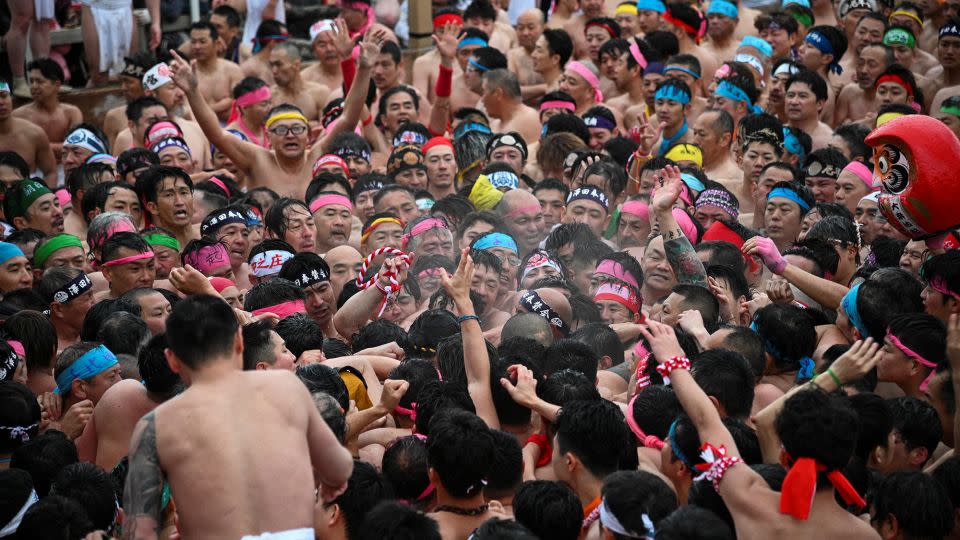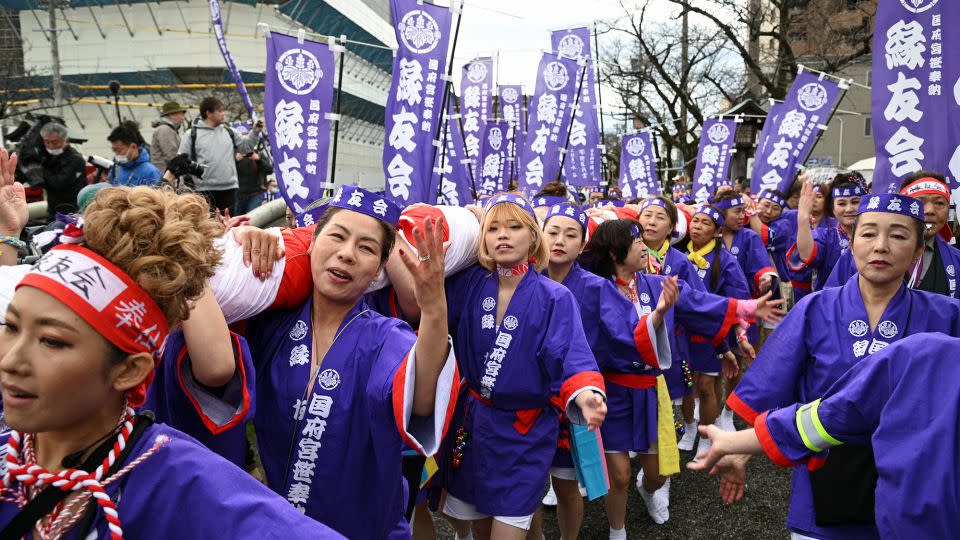Women’s participation in ‘naked festival’ a sign of how aging is forcing changes to male-centric Japanese traditions
With a history spanning more than 1,200 years, “hadaka matsuri,” or the naked festival, is Japanese masculinity on full display. Quite literally.
Across Japan, in freezing winter, thousands of men strip naked — except for a delicate piece of crotch-covering white loincloth — to jostle around their local shrines. Each participant tries to get as close as possible to a man playing the role of “shin-otoko,” a god-man who wards off bad luck.
On one hand, the ritual illustrates Japan’s steadfast respect for tradition and cultural heritage. But on the other, its insistence on excluding women — only men are considered pure in the traditional Japanese culture — bears all the hallmarks of one of the country’s greatest modern struggles: gender inequality.
To this day, men hold the country’s highest offices and most of the top jobs at prestigious private firms.
Last year, the World Economic Forum ranked Japan 125th in its Global Gender Gap Index report, far below other G7 countries such as Germany, Britain and the United States. It was just a few spots ahead of India and Saudi Arabia — both notoriously poor performers on gender equality.
Some women in Japan still battle deep-rooted cultural expectations that require them to take the role of “shufu,” or housewife, experts say. Meanwhile, the country’s painstakingly long work hours and male-centric institutional culture conspire further against women who are already burdened disproportionately by more family duties than men.
But in the naked festival, women have recently found hope. Even the country’s most entrenched male-centric tradition was recently subverted by another wrinkle in the national fabric: a shrinking population.

In February, as the number of male participants dwindled, the country’s oldest hadaka matsuri, at the Konomiya Shrine in central Japan, welcomed 41 women to take part for the first time.
“One reason to permit women to participate in such a traditional festival is due to the shortage of men,” said Mikiko Eto, emerita professor who specializes in gender politics at Hosei University in Tokyo.
“The number of young men is declining rapidly. Women should be welcome because of shortage of male participants, so we’ve been very welcome.”
Haruhiko Nishio, 57, a member of an alumni club for shin-otoko involved in organizing the hadaka matsuri at the Konomiya Shrine, recalled: “Last year, the festival had only 1,700 attendees, only one-fifth of pre-pandemic crowds.”
He said women had never been explicitly banned from taking part, but such mass participation was a first.
The female group, known as Enyukai, was assigned a minor role on the day (and the women agreed they should keep their clothes on). But for those who took part, it was deeply symbolic.
“Japan can’t help but put men at the front and women in the back. I want to unleash female power from now on,” participant Atsuko Tamakoshi, 56, told CNN.

For the organizer, it may be a practical decision. But vice president of Enyukai, Ayaka Suzuki, 36, said: “It’s about gender equality.”
It does not end there, scholars say. With no easy solutions in sight, Japan’s declining population may not only reshape the millennium-old festival, but also transform the world’s fourth-biggest economy.
“The impact of an aging society is very important for the Japanese economy. You need more working people, more active people. So why are women still at home? Let women participate in the labor market,” Eto said.
“Aging society is a chance for women to achieve gender equality because our society needs more able people,” she said.
‘Now or never’
Japan’s number of births dropped for the eighth consecutive year in 2023, plunging 5.1% from the previous year to an all-time low of 758,631, according to the Ministry of Health.
With a fertility rate hovering around 1.3 in recent years — far below the rate of 2.1 required to maintain a stable population (Japan has very low levels of immigration) — the Japanese government has long described its mission to boost births as a question of “now or never.”
Eto, from Hosei University, said the consequences of a declining population aren’t confined to small towns or traditional rituals.
Japan’s workforce totaled 66 million people in 2023, including foreign nationals, according to a report released in January this year by the Organization for Economic Cooperation and Development (OECD). But the figure will plunge by more than half to about 32 million by the turn of the century if Japan’s fertility rate continues to stagnate, the report predicted.
And as the population crisis spirals, the government and many businesses have started asking why women are still bound by social expectation to stay home, Eto said.
Amplified voices
There have been improvements, according to Eto, though — as with the changes to the hadaka matsuri — the motives may have been more pragmatic than progressive.
Many businesses are promoting greater gender equality in workplaces to make women feel more welcome. The government has also introduced a string of initiatives to lessen the burdens on mothers, including a vision to encourage 85% of male workers to take paternity leave by 2030, for a more even division of domestic labor.
Examples of women leaders include Mitsuko Tottori, who took the helm of Japan Airlines on April 1 to become its first female president and CEO. Seasoned politician Yoko Kamikawa was appointed foreign minister last September, becoming the first woman to take up the role in two decades.
But in general, women’s representation in politics and management remains unsatisfactorily low, experts note. Only five of Prime Minister Fumio Kishida’s 20-member cabinet are women and, as of 2023, less than 13% of senior and leadership posts in businesses were held by women, according to the Global Gender Gap report.
A lack of innovative policies, such as quota systems for women adopted by some European countries, is holding Japan back, Eto said.
Kaori Katada, an associate social science professor at Hosei University, said Japan’s improvement on gender equality has been incremental and nuanced. While women are given more opportunities, she said, bias and stereotypes persist.
Women are mostly confined to junior positions and caretaking jobs, such as kindergarten care and nursing, and they are generally paid less than their male counterparts, she said.
“(This means) women have to take care of the house and children, which forces them into part-time work. They cannot accept high-responsibility management positions because they need to look after children too,” she said.
And not all social institutions are ready to embrace women as much as the hadaka matsuri at Konomiya Shrine, as the handful of women who try to set foot in the ring of sumo wrestling, another male-dominated sport, can testify.
Hiyori Kon, 26, a top amateur sumo wrestler and the protagonist in the 2018 Netflix documentary “Little Miss Sumo,” told CNN she is often confronted by disapproval, reminding her that Japan has a long way to go on gender equality. Once, she said, her male colleague told her: “If you continue sumo, you won’t be able to marry, so you better quit soon.”
For more CNN news and newsletters create an account at CNN.com

